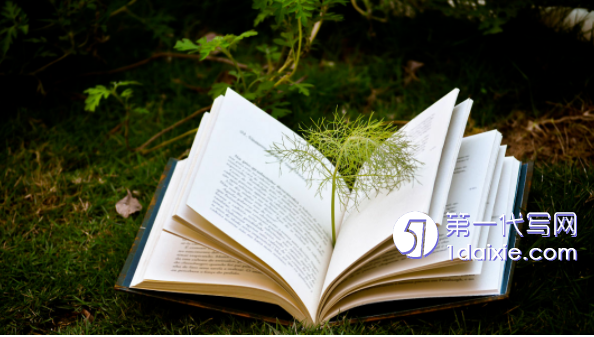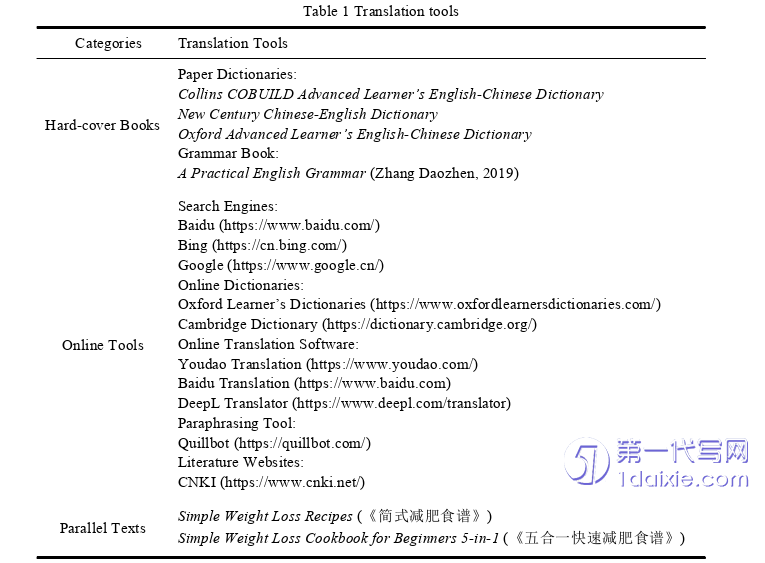本文是一篇英语毕业论文,笔者在翻译过程中,最大限度地保留了原作的真实情感和语言风格,尽可能使译文像原文一样自然流畅。在内容忠实方面,主要采用了转换、重复、省略和反译的翻译技巧来保证翻译的忠实性;在风格一致方面,主要运用了选词和顺译以确保源文本与目标文本在风格上保持一致;在文本流畅方面,主要应用了增译、分译、语态转换、替代和重组,使译文流畅自然。
Chapter 1 Task Description
1.1 Selection of the Source Text
The book Futuresteading is highly rated and is available on Amazon.So far,therehas been no Chinese translation of this book and the translator has acquired thetranslation permission of the publisher.
There are 312 pages of this book,covering 80,229 words in total.After gaining ageneral understanding of the book,the translator decided to select the last part“DeepChill”of the second section as the translation material.The selected part consists of 34pages,including 9,833 words,which can be rendered into over 16,000 Chinese characters.This part describes the winter life in Victoria,Australia,full of life tips and gardeninspiration,along with a great deal of rewarding recipes for slow,nourishing and easymeals.Topics covered in this part include decluttering,self-nourishment,DIY cleaningproducts,sprouting seeds,creating a stick fence,making a compost,numeroushealthy and nutritious recipes and so on.
The reasons why the translator selected“Deep Chill”as the translation material areas follows.Firstly,today’s fast pace of life compels people to relentlessly pursue career,love,social status and wealth,and they are afraid of being left behind.However,work isonly a part of life,and other pleasures should not be neglected.This part encouragespeople to enjoy life and cherish tomorrow.The translator appreciates the author’s attitudetowards life and believes that this attitude is worth learning for people in today’s society.Secondly,as a chapter with a wealth of practical advice and inspiration to help readers totake small steps towards a sustainable lifestyle while experiencing other cultures,there isplenty to read and enjoy,allowing readers to get a spiritual purification in their spare time

1.2 Analysis of the Source Text
There are numerous details about the source text in this part,including theintroduction to the book and the characteristics of the source text.
1.2.1 Introduction to the source text
Published by Murdoch Books in 2021,the captivating work Futuresteading aims atconveying the idea that tomorrow is important,encouraging people to cherish everyminute of today while diligently cultivating a rich and colorful future.The entire bookrevolves around the concept of“Futuresteading”,defining success as a healthy family,strong interpersonal relationships,an elegant and frugal household,a closely-knitcommunity,virtuous behavior,creative achievements,integrity,rituals,a connection withnature,and a simple way of life.It invites people to respect the future in their own way.The author also emphasizes that humans should not stand above nature,as they are not itsmasters or creators,but rather a part of it.This book is structured into two major sections:“The Why”and“The How”.“The Why”explains the seven pillars on whichFuturesteading is based,and the summary at the end of each section provides readerswith practical suggestions as to how to embrace the particular pillar being discussed.“The How”follows the cycle of the seasons and provides readers with an abundance ofinformation as to how to maximize benefits from the bountiful gifts of nature.Beyondbeing an inspiring read,it also serves as a splendid manual for being more self-sufficient.The final chapter“Deep Chill”has been selected as the translation material.
Chapter 2 Theoretical Framework
2.1 Tytler’s Three Principles of Translation
Alexander Fraser Tytler(1747-1814)is a prominent British landmark figure in thewestern translation history.Prior to him,translation theories were relatively dispersedand unsystematic,with no specific translation treatises to guide practice.He had givenpapers on translation and poetry at the Royal Society of Edinburgh for many times,andthen all his papers were compiled into one volume and became the book Essay on thePrinciples of Translation published in 1790.This book is not only the first completetreatise on translation theory,but also one of the most influential treatises marking thebeginning of modern western translation studies.In this book,Tytler(1978)presents awidely accepted definition of a“good translation”.He believes that a good translationboasts all the advantages of the original work and it can enable the target languagereaders to comprehend these advantages clearly and have the same strong feeling just likethe source language readers(Tan,2004).On this basis,Tytler(1978)creatively putsforward the famous“Three Principles of Translation”.Tytler’s translation theory is notconfined to fragmented methods and viewpoints,but rather follows a comprehensive,scientific and systematic approach.Detailed explanations of these three principles areprovided below.
Firstly,the translation should give a complete transcript of the idea of the originalwork(Tytler,1978).This principle emphasizes the fidelity of translation.The“idea of theoriginal work”refers to its content,which contains the author’s thoughts and serves asthe basis for the translator’s creation,whereas the target readers acquire ideas from thetranslated version.From this perspective,the significance of the original work is self-evident.The author uses his work to elaborate on ideas and provoke reflection in readers,whereas the translator’s primary task is to reproduce the main ideas.
2.2 Related Studies of Tytler’s Three Principles of Translation
This section provides an overview of domestic and international literature pertinentto Tytler’s Three Principles of Translation.
2.2.1 Overseas studies of Tytler’s Three Principles of Translation
Given the widespread recognition of Tytler’s Three Principles of Translation,numerous foreign translation scholars have conducted research and offered theirviewpoints on these three principles.
Wonderly,William and Nida(1963)hold that the criteria of a good translation statedby the notable British translator,George Campbell,closely resembled those advocated byTytler in 1790,exerting a significant influence on the field of translation.Both Campbelland Tytler stress the importance of fidelity and fluency in translation.Nevertheless,scholars and translators in the 19th century leaned more towards literal and pedantictranslation,rather than widely adopting the translation principles advocated by Campbelland Tytler.
Kingscott(1991)believes that Tytler’s Three Principles of Translation have neverbeen surpassed in English as a set of general precepts for translators.His masterpieceEssay on the Principles of Translation is still largely regarded as a treatise on translation.It is difficult to disagree with Tytler’s point of view,as his judgments are well-foundedand presented more clearly than many modern writers,and the examples he listedeffectively illustrate his arguments.
Chapter 3 Translation Process ................................ 14
3.1 Pre-translation Preparation .......................... 14
3.2 While-translation Procedure .................................. 16
3.3 Post-translation Proofreading ................................ 17
Chapter 4 Case Analysis .......................................... 19
4.1 Content Fidelity ..................................... 19
4.1.1 Conversion .................................. 19
4.1.2 Repetition ............20
Chapter 5 Conclusion .................................. 45
5.1 Major Gains.......................................... 45
5.2 Limitations ................................ 46
Chapter 4 Case Analysis
4.1 Content Fidelity
The most fundamental requirement of translation is to stay close to the original text(Zhou,2020).The first principle,as noted above,is that“the translation should give acomplete transcript of the idea of the original work”(Tytler,1978:17).That is,contentfidelity,which means the main task of the first principle is to convey the information ofthe source text.Tytler(1978)believes that the proficiency in the source language andfamiliarity with the subject are prerequisites for fully transcribing the idea of the original.If the meaning of the original text is obscure or ambiguous,translators can have thefreedom to add or omit,but the content needs to be handled flexibly withoutcontradicting the ideas of the original work.Based on this principle,conversion,repetition,omission and negation have been employed in this section in order to betterconvey the information,fostering a better understanding of the original text for the targettext readers.
4.1.1 Conversion
In the course of translation,the translation technique,known as conversion,isfrequently used by translators.Conversion is the process of converting word classes andsentence patterns such that the translation faithfully conveys the content of the originalwork while also conforming to the writing habits of the target language(Xu,2018).If asentence in English cannot be translated smoothly into Chinese,the issue can bemiraculously resolved by employing conversion to alter the parts of speech of certainwords.This demonstrates that word classes in the original text should not beoveremphasized by translators(Ye,2007).

Chapter 5 Conclusion
5.1 Major Gains
The composition of the translation practice report is an essential process forsummarizing and reflecting on the translation.Through this process,many valuable gainshave been achieved,including but not limited to the following.
To start with,the translator has accumulated a wealth of professional knowledge,deepening the understanding and application of Tytler’s Three Principles of Translationand translation techniques.Previously,the translator had only a superficial understandingof the theory and translation techniques,and had not delved deeply into them.Forexample,at first,the translator had a misconception about the translation technique“diction”,selecting words at random and neglecting the significance of context.Thetranslator initially categorized this technique under Tytler’s first principle of translation.Despite the fact that this technique can indeed be attributed to the first principle,it ismore appropriately associated with the second principle,as it involves selecting wordsbased on the context to better reflect the original style.After receiving instructions fromthe supervisors and conducting in-depth research,the translator realized that the selectionof words was mainly based on the context and it could be further categorized into fourtypes,as mentioned earlier.Translators should never focus solely on the word itself.Theymust take the context into account and focus on conveying the intended meaning(Cai,2020).Moreover,the translation theory is closely related to the quality of the translation,and translation practice cannot be separated from theoretical guidance.Although somemay argue against the necessity of translation theory,it provides a set of principles that,when followed,guarantee the quality of the translation.
reference(omitted)
